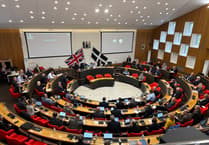Ahead of Earth Day 2023, people living in Cornwall can now see in unique detail how average annual temperatures have changed where they live over the last century.
Places across the UK reported their warmest year on record as temperatures continue to rise rapidly, striking new graphics show.
This data has been visualised in the latest versions of the “warming stripes” graphics, which have been released today (Friday, 21 April), and now include new localised stripes for Cornwall.
The stripes show the change in temperature from the past 100 plus years, with shades of blue indicating cooler-than-average years, and red showing years that were hotter than average.
The stripes were created by leading climate scientist Professor Ed Hawkins in partnership with UK charity Carbon Copy.
Linked to the charity’s interactive Carbon Zero Explorer tool, people in Cornwall are now able to download their stripes, as well as finding out more about carbon emissions and climate action plans in their local area.
These new stripes are the latest in a collection of graphics that Ed has been developing over the past few years. Initially creating warming stripes for the planet as a whole, Professor Hawkins and his team moved onto continents, countries and now – using data from the Met Office – counties in the UK.
Similarly to the whole-UK climate graphic, which features a new dark red bar representing the hottest year on record in 2022, the visualisation for Cornwall shows unprecedented temperatures in the last 12 months.
Carbon Copy co-founder Ric Casale said: “We know that effects of climate change: bigger storms, longer summer droughts, and more flooding – are happening right now, right here. Climate change is no longer an abstract issue for someone else to deal with, it’s something that people in the UK can see and feel locally, where they live.
“These warming stripes enable us to clearly see the changing climate in local areas.
“They can be used in lots of different ways, and can help to start conversations about reducing carbon emissions and preventing the catastrophic effects of further warming.”





Comments
This article has no comments yet. Be the first to leave a comment.